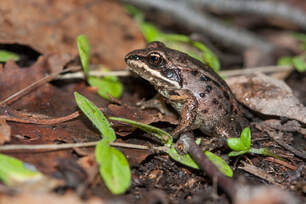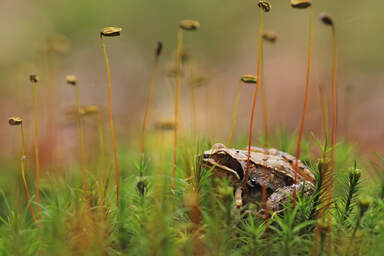 Reaching body lengths of 1.5 to 3.25 inches, these stocky frogs blend in exquisitely with their surroundings. Sporting colors of muted green, gray, brown, red and even salmon, and adorned with their unmistakable mask of dark brown to black which drapes over their eyes and snout, there is no confusing this amphibian. Found from the lowlands of Alabama to the forests of Idaho, and from the woodlands of New England, to even the Alaskan tundra, Wood Frogs are the only frog species known to range north of the Arctic Circle! So how do they do it? How do these creatures–which cannot generate body heat–adapt to such a forbidding northern climate? The answer seems more science fiction than science fact. The Wood Frog’s remarkable cold climate adaptations include the ability to enter an extreme hibernation state which enables it to suspend its respiration, heartbeat–in fact all bodily functions. Invariably, the little kid in us has a favorite superhero.Think back, you know who they are. For me, animals are nature’s version of these greats and I would demand nothing more of my superheroes than the ability to enter such suspended animation.  Yet the Wood Frog goes beyond remarkable and leaps right into the realm of incredible with it’s next adaptation. They are the only vertebrates, or animals with a backbone, which are known to survive the freezing process. You read that right! They can actually withstand freezing which explodes the cells of all other vertebrates, leading to death. The key to their death-defying feat is in their ability to “Manage the freeze”. Wood Frog cells remain protected due to unique spacing properties which accommodate ice crystals in the spaces in between the cells. What’s more, they can synthesize glucose and accumulated bodily wastes, which serve as cryoprotectants, protecting cells, sensitive tissues and organs from sub-freezing conditions. In this way, the frogs don’t require warmth, freeze for months on end, conserve energy, and emerge once their bodies literally thaw. “Wow!” I thought I’d write it because we were all thinking “Wow!”. The frog’s ability to freeze and thaw its blood, withstand glucose spikes 100 times normal levels and restart its circulatory processes without any damage, offers an intriguing path for research in medical science. Unlike their long-legged kin who must gradually emerge from their winter haunts below frost line in soil or mud, the Wood Frog’s quick thaw and cold tolerance gives it a jump start on the competition. This translates to access to vernal pools and wetlands before most predators are on the hunt and assures them first place in line for the all-you-can-eat buffet of insects and other invertebrates the moment their prey emerge from their winter sleep. Such timing is indeed everything and the Wood Frog benefits like no other amphibian, dominating the cold regions of North America from related species and holding an exclusive domain in the Great White North.
Such amazing adaptations are not the frog’s only contribution to science. As amphibians, and Fairfield County amphibians at that, Wood Frogs help us by showing the way. As a biological bellwether species, their mere presence and abundance in a region indicates biodiversity levels as well as environmental health of the water, soil, air and the overall biological community. This is precisely why we are studying them through the Peabody-Beardsley-Maritime Chapter of FrogWatch USA. This ongoing national citizen science initiative provides frog lovers of all ages with opportunities to learn from zoological professionals, conduct field conservation through trained study of frog calls and enter their data into a national database which helps generations of frogs and humans alike. If you or someone you know would like to get involved in helping our slimy friends–and have fun in the process–I encourage you to look at our website for more information. Given the dynamic nature of our planet, the need to study its animal superheroes has never been greater or offered the promise of more fascinating discoveries. In the Wood Frog, we have a humble creature in our midst who makes the seeming impossible–possible, and a marvel of the natural world who gives us pause to reflect on the true identity of the superhero behind the mask. This blog post first appeared in the Greenwich Sentinel on March 15, 2020, as part of their Wildly Successful series by Jim Knox.
1 Comment
princess aurora
3/18/2024 05:45:17 pm
LOVE THIS keep it up!
Reply
Leave a Reply. |
Archives
July 2024
|
Connecticut’s Beardsley Zoo is dedicated to acquainting a diverse public to the delicate balance that exists between living things and their environment.
Connecticut's Beardsley Zoo is a 501(c)(3) not for profit owned and operated by the Connecticut Zoological Society.
Connecticut's Beardsley Zoo is a 501(c)(3) not for profit owned and operated by the Connecticut Zoological Society.
© 2022 Connecticut's Beardsley Zoo


 RSS Feed
RSS Feed





